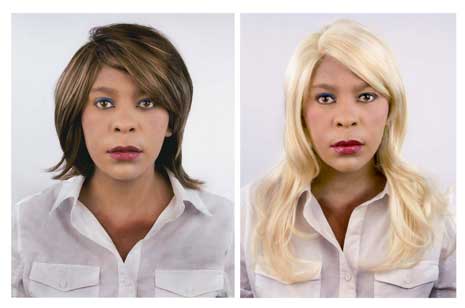Portrait of an Artist: Heidi Fancher
This is the fourth in a series of interviews with artists participating in the Outwin Boochever Portrait Competition. The third OBPC exhibition opens on March 23, 2013, and will run through February 23, 2014. It will feature the works of forty-eight artists in many forms of media.

Q: What is your name, where are you from, where do you live now?
A: My name is Heidi Fancher; I currently reside in Washington, DC. I have recently relocated back to DC from Georgia.
Q: What medium(s) do you work with?
A: I take an interdisciplinary approach to my work. I work in painting, drawing, sculpture, video, photography, and textiles. Currently I am working with discarded technology to create new, expressive tools. This is often a challenge, as parts become hard to find and technology standards change.
Q: Tell us about your technique/creative process.
A: I have two parts to my creative process. The first part is research. I study primary source material on the subject matter that I am interested in. The second part is to scour archives for visual and audio materials that will inform my research and that further inspire me.
Living in Washington is a perfect match for my creative process, because it has some of the best archival sources. Very often I will also visit the place that I am researching.
Q: What is your background (education, career, etc.) and how does it contribute to your art?
A: I have a BFA in photography and an MFA in photography/electronic media. I have also worked as a photographic archivist.
Q: How did you learn about the Outwin Boochever Portrait Competition?
A: I saw the 2009 show and was inspired!
Q: Tell us about the piece you submitted to the competition.
A: The piece I submitted for the Outwin Boochever Portrait Competition is titled For Delia. In 2004 a friend invited me to view a collection of daguerreotypes at the Peabody Museum of Archaeology and Ethnology at Harvard University. I saw all of the daguerreotypes within that collection but it was the daguerreotype of Delia that captivated me. Her gaze is penetrating. I have been obsessed with her ever since. After viewing the portrait, I wanted to give Delia a voice.
Q: Tell us about your larger body of work.
A: My body of work thus far has been about giving voice to those who have traditionally been shut out of the American conversation by the majority culture due to their ethnicity, sex, and race.
Q: What are you currently working on?
A: While in Georgia, I lived across the street from the Georgia Historical Society. I spent two years scouring their archive. From that research I have begun to weave narratives of the people who settled there. I am currently putting together a body of work that employs video, photography, sound sculpting, and sculptural pieces.
Q: How has your work changed over time?
A: This is a difficult question to answer because I feel that I have always been employing multiple mediums in my work. Perhaps, looking backward, my work is more focused now than it was when I was younger.
Q: Tell us about a seminal experience you’ve had as an artist.
A: The seeds for all my work came from my introduction to the photographic archives.
Q: Who is your favorite artist?
A: This is a difficult question for me, my favorite artist changes often—right now I love the work of Caravaggio. I admire his use of chiaroscuro. I also admire the work of Terence Koh and Lusi Gispert.
Q: If you could work with any artist (past or present) who would it be?
A: London–born artist and filmmaker Steve McQueen.
Q: What is your favorite artwork?
A: Ever is Over All by Pipilotti Rist.
Q: What inspires you?
A: I am inspired by people’s stories, their lives, their hopes, and their histories.